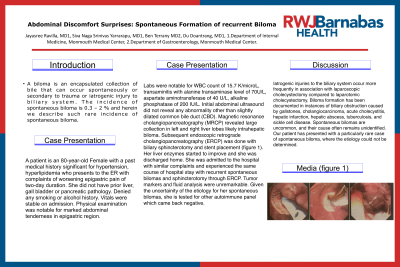Tuesday Poster Session
Category: Biliary/Pancreas
P3534 - Abdominal Discomfort Surprises: Spontaneous Formation of Recurrent Biloma
Tuesday, October 29, 2024
10:30 AM - 4:00 PM ET
Location: Exhibit Hall E

Has Audio
- JR
Jayasree Ravilla, MD
Monmouth Medical Center
Long Branch, NJ
Presenting Author(s)
Jayasree Ravilla, MD, Siva Naga Yarrarapu, MD, Ben Terrany, MD, Doantrang Du, MD
Monmouth Medical Center, Long Branch, NJ
Introduction: A biloma is an encapsulated collection of bile that can occur spontaneously or secondary to trauma or iatrogenic injury to biliary system. The incidence of spontaneous biloma is 0.3 – 2 % and herein we describe such rare incidence of spontaneous biloma.
Case Description/Methods: The patient is an 80-year-old female with a past medical history significant for hypertension, hyperlipidemia who presents to the ER with complaints of worsening epigastric pain of two-day duration. She did not have prior liver, gall bladder or pancreatic pathology. Denied any smoking or alcohol history. Vitals were stable on admission. Physical examination was notable for marked abdominal tenderness in epigastric region. Labs were notable for WBC count of 15.7 K/microL, transaminitis with alanine transaminase level of 70U/L, aspartate aminotransferase of 40 U/L, alkaline phosphatase of 200 IU/L. Initial abdominal ultrasound did not reveal any abnormality other than slightly dilated common bile duct (CBD). Magnetic resonance cholangiopancreatography (MRCP) revealed large collection in left and right liver lobes likely intrahepatic biloma. Subsequent endoscopic retrograde cholangiopancreatography (ERCP) was done with biliary sphincterotomy and stent placement (figure 1). Her liver enzymes started to improve and she was discharged home. She was admitted to the hospital with similar complaints and experienced the same course of hospital stay with recurrent spontaneous bilomas and sphincterotomy through ERCP. Tumor markers and fluid analysis were unremarkable. Given the uncertainity of the etiology for her spontaneous bilomas, she is tested for other autoimmune panel which came back negative.
Discussion: Iatrogenic injuries to the biliary system occur more frequently in association with laparoscopic cholecystectomy compared to laparotomic cholecystectomy. Biloma formation has been documented in instances of biliary obstruction caused by gallstones, cholangiocarcinoma, acute cholecystitis, hepatic infarction, hepatic abscess, tuberculosis, and sickle cell disease. Spontaneous bilomas are uncommon, and their cause often remains unidentified. Our patient has presented with a particularly rare case of spontaneous biloma, where the etiology could not be determined.

Disclosures:
Jayasree Ravilla, MD, Siva Naga Yarrarapu, MD, Ben Terrany, MD, Doantrang Du, MD. P3534 - Abdominal Discomfort Surprises: Spontaneous Formation of Recurrent Biloma, ACG 2024 Annual Scientific Meeting Abstracts. Philadelphia, PA: American College of Gastroenterology.
Monmouth Medical Center, Long Branch, NJ
Introduction: A biloma is an encapsulated collection of bile that can occur spontaneously or secondary to trauma or iatrogenic injury to biliary system. The incidence of spontaneous biloma is 0.3 – 2 % and herein we describe such rare incidence of spontaneous biloma.
Case Description/Methods: The patient is an 80-year-old female with a past medical history significant for hypertension, hyperlipidemia who presents to the ER with complaints of worsening epigastric pain of two-day duration. She did not have prior liver, gall bladder or pancreatic pathology. Denied any smoking or alcohol history. Vitals were stable on admission. Physical examination was notable for marked abdominal tenderness in epigastric region. Labs were notable for WBC count of 15.7 K/microL, transaminitis with alanine transaminase level of 70U/L, aspartate aminotransferase of 40 U/L, alkaline phosphatase of 200 IU/L. Initial abdominal ultrasound did not reveal any abnormality other than slightly dilated common bile duct (CBD). Magnetic resonance cholangiopancreatography (MRCP) revealed large collection in left and right liver lobes likely intrahepatic biloma. Subsequent endoscopic retrograde cholangiopancreatography (ERCP) was done with biliary sphincterotomy and stent placement (figure 1). Her liver enzymes started to improve and she was discharged home. She was admitted to the hospital with similar complaints and experienced the same course of hospital stay with recurrent spontaneous bilomas and sphincterotomy through ERCP. Tumor markers and fluid analysis were unremarkable. Given the uncertainity of the etiology for her spontaneous bilomas, she is tested for other autoimmune panel which came back negative.
Discussion: Iatrogenic injuries to the biliary system occur more frequently in association with laparoscopic cholecystectomy compared to laparotomic cholecystectomy. Biloma formation has been documented in instances of biliary obstruction caused by gallstones, cholangiocarcinoma, acute cholecystitis, hepatic infarction, hepatic abscess, tuberculosis, and sickle cell disease. Spontaneous bilomas are uncommon, and their cause often remains unidentified. Our patient has presented with a particularly rare case of spontaneous biloma, where the etiology could not be determined.

Figure: ERCP showing biloma with subsequent sphincterotomy.
Disclosures:
Jayasree Ravilla indicated no relevant financial relationships.
Siva Naga Yarrarapu indicated no relevant financial relationships.
Ben Terrany indicated no relevant financial relationships.
Doantrang Du indicated no relevant financial relationships.
Jayasree Ravilla, MD, Siva Naga Yarrarapu, MD, Ben Terrany, MD, Doantrang Du, MD. P3534 - Abdominal Discomfort Surprises: Spontaneous Formation of Recurrent Biloma, ACG 2024 Annual Scientific Meeting Abstracts. Philadelphia, PA: American College of Gastroenterology.
